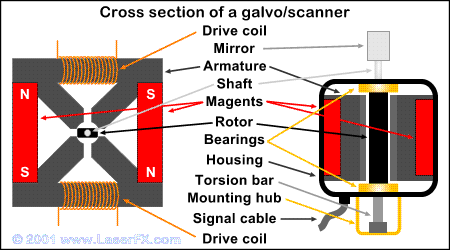Contrasting Different Designs of Galvanometer Scanners for Optimum Performance in Labs
Contrasting Different Designs of Galvanometer Scanners for Optimum Performance in Labs
Blog Article
Key Applications of a Galvanometer Scanner in Various Scientific Research Study Area
Galvanometer scanners have become essential to various clinical research study areas, supplying boosted accuracy in applications ranging from biomedical imaging to environmental tracking. Their ability to promote high-resolution imaging techniques, such as confocal microscopy, plays a crucial role in advancing our understanding of mobile structures. Moreover, in product processing, these devices improve the precision of laser cutting and welding. As we discover the multifaceted applications of galvanometer scanners, it ends up being noticeable that their influence extends far beyond plain technical capacities, elevating concerns regarding their future possibility in arising research areas.
Biomedical Imaging

In confocal microscopy, galvanometer scanners promote the purchase of pictures with improved resolution and comparison, permitting researchers to visualize cellular components in vivo. The capacity to swiftly record multiple focal aircrafts improves the three-dimensional reconstruction of cells, offering critical understandings right into their architecture and feature.

Additionally, the quick scanning capacities of galvanometer systems add to innovations in dynamic imaging applications, such as keeping track of cellular actions to stimuli. For this reason, galvanometer scanners are vital tools in the area of biomedical imaging, advancing research study and professional diagnostics via their accuracy and effectiveness.
Product Handling
Accuracy in material processing is vital for accomplishing top notch lead to numerous commercial applications (galvanometer scanner). Galvanometer scanners play an essential function in enhancing this precision by making it possible for precise and fast motion control throughout the processing of products such as metals, porcelains, and polymers. These devices assist in methods like laser cutting, engraving, and welding, which require finely-tuned modifications to make certain ideal end results
In laser cutting, as an example, galvanometer scanners enable intricate styles to be executed with high integrity, decreasing waste and enhancing manufacturing effectiveness. The fast activity abilities make it possible for quick modifications in the laser beam of light course, which is important for keeping consistent cutting high quality throughout varying product thicknesses. Similarly, in laser welding applications, the accuracy used by galvanometer scanners makes sure strong joints with marginal thermal distortion, thereby boosting structural integrity.
Furthermore, the versatility of galvanometer scanners to various laser kinds and wavelengths even more widens their utility in product handling. Their ability to operate in tandem with advanced software application for real-time monitoring and control includes an extra layer of refinement, enabling makers to achieve exact specifications customized to specific applications. Thus, galvanometer scanners are indispensable beforehand the capabilities of product handling technologies.
Optical Characterization
In the realm of optical characterization, the function of galvanometer scanners ends up being progressively substantial as they assist in the evaluation of different optical properties with high precision. These tools allow accurate control of laser beams, enabling scientists to systematically probe materials at multiple angles and regularities. This ability is vital for characterizing the refractive index, absorption coefficient, and spreading homes of diverse products.
Galvanometer scanners are especially reliable in methods such as optical coherence tomography (OCT) and laser-induced fluorescence (LIF), where rapid scanning is important. By accomplishing high-speed modulation of the laser placement, galvanometer scanners improve the temporal resolution of these techniques, causing enhanced imaging and analysis. In addition, they make it possible for the exploration of complex interactions between light and matter, which is essential read this article for comprehending product habits under different problems.
Additionally, the assimilation of galvanometer scanners with spectroscopic techniques expands their utility, enabling detailed spooky evaluation across a vast array of wavelengths. This flexibility makes them vital devices in fields such as products science, biomedical research study, and nanotechnology, where thorough optical characterization is paramount for progressing knowledge and innovation.

Laser Micromachining
The development of laser micromachining has reinvented producing processes, enabling the creation of intricate frameworks with exceptional accuracy. This technique uses high-intensity laser beams to exactly remove material from a substratum, making it possible to produce micro-scale elements that are essential in various sectors. The application of galvanometer scanners in laser micromachining boosts the effectiveness and precision of this procedure by enabling precise and rapid light beam positioning.
Galvanometer scanners facilitate the dynamic control of laser beams, allowing complicated patterns to be engraved or look at here now cut with high fidelity. Their fast feedback times and high-resolution abilities permit for the manipulation of laser pulses, which is necessary for achieving the desired material residential properties and surface area finishes. This innovation is particularly helpful in sectors such as electronics, where the miniaturization of parts is necessary for efficiency enhancement.
Furthermore, laser micromachining is significantly being used in the medical field for manufacturing precision instruments and implants. The combination of laser technology and galvanometer scanning not only enhances production process however additionally reduces waste and improves general material usage, making it a lasting choice for contemporary production challenges.
Environmental Surveillance
Ecological monitoring has come to be significantly crucial in assessing and managing the health of ecosystems and urban environments. The integration of galvanometer scanners in this field allows specific, rapid, and efficient data collection, facilitating far better decision-making procedures. These scanners are skilled at routing laser beams or sensors across numerous terrains, permitting for high-resolution mapping of environmental criteria such as air quality, dirt structure, and water contamination.
In air quality surveillance, galvanometer scanners can be employed to analyze particulate matter and gaseous pollutants, providing real-time data that educates public health efforts. For water top quality assessments, these scanners can help in finding impurities and measuring physical criteria, thus guaranteeing conformity with environmental policies. In remote picking up applications, galvanometer scanners enhance the capability of satellite and drone systems to capture in-depth images and data of substantial locations, determining anthropogenic effects and ecological why not find out more adjustments.
The adaptability and accuracy of galvanometer scanners make them indispensable tools in ecological tracking, adding significantly to sustainable development initiatives and the defense of all-natural resources. As the demand for effective environmental management grows, the duty of these advanced devices will unquestionably broaden additionally.
Conclusion
In summary, galvanometer scanners serve as essential devices across numerous clinical research study domain names. The flexibility and efficiency of galvanometer scanners proceed to drive improvements in these crucial fields.
In laser welding applications, the accuracy provided by galvanometer scanners ensures solid joints with very little thermal distortion, therefore improving architectural integrity.
Moreover, the flexibility of galvanometer scanners to different laser types and wavelengths even more widens their energy in material processing. By achieving high-speed modulation of the laser setting, galvanometer scanners boost the temporal resolution of these approaches, leading to improved imaging and evaluation. The application of galvanometer scanners in laser micromachining enhances the efficiency and precision of this process by permitting quick and accurate beam positioning.
Galvanometer scanners promote the vibrant control of laser beams, making it possible for intricate patterns to be etched or reduced with high integrity.
Report this page